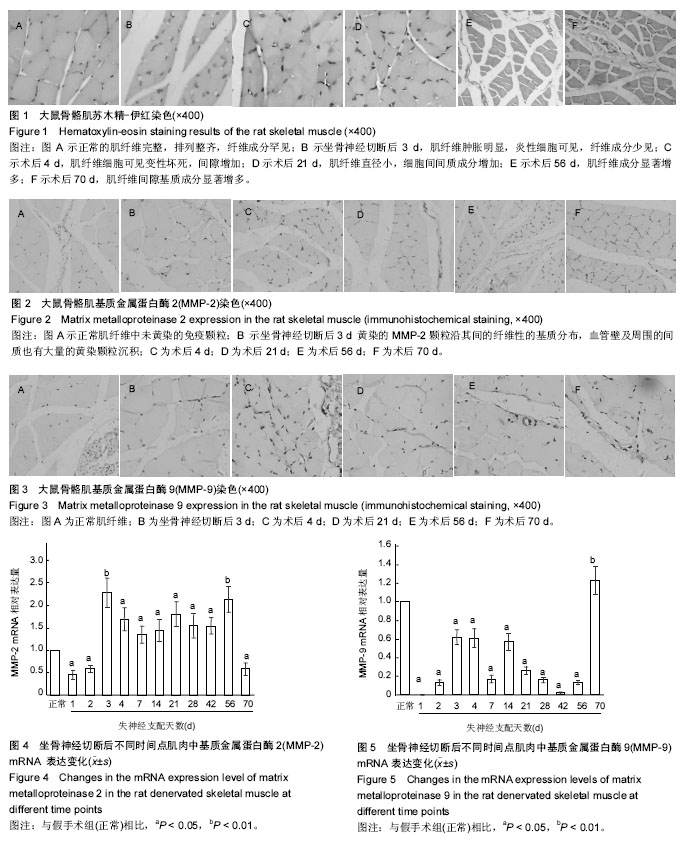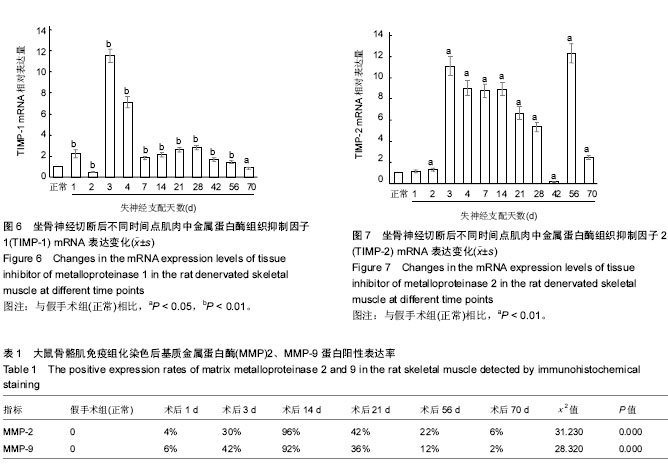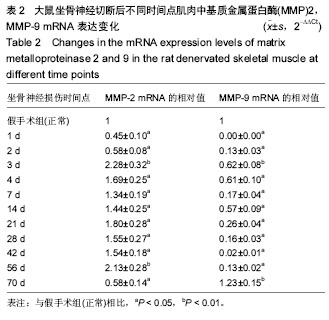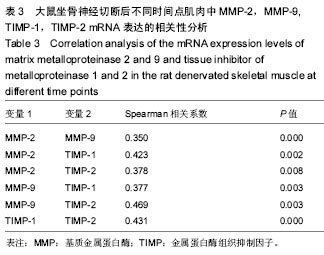| [1] Reznick AZ, Menashe O, Bar Shai M, et al. Expression of matrix metallop roteinases, inhibitor, and acid phosphatase in muscles of immobilized hindlimbs of rats. Muscle Nerve. 2003; 27 (1):51-59.[2] Siqueira AS, Carvalho MR, Monteiro AC, et al. Matrix metalloproteinases, TIMPs and growth factors regulating ameloblastoma behaviour. Histopathology. 2010;57: 128-137.[3] Belkin AM,Akimov SS,Zaritskaya LS,et al. Matrix-dependent proteolysis of surface transglutaminase by membrane-type metalloproteinase regulates cancer cell adhesion and locomotion.J Biol Chem. 2001;276(21):1415-1422.[4] Visse R,Nagess H.Matrix metalloproteinasss and tissue inhibitom of metallopmt- einases:structure,function,and biochemistry. Cire Res. 2003;92:827-839.[5] Carmeli E, Moas M, Reznick A, Coleman R: Matrix metalloproteinases and skeletal muscle: a brief review. Muscle Nerve. 2004;29:191-197.[6] Kherif S, Lafuma C, Dehaupas M, et al. Expression of matrix metalloproteinases 2 and 9 in regenerating skeletal muscle: a study in experimentally injured and mdx muscles. Dev Biol. 1999;205:158-170.[7] Ohtake Y, Tojo H, Seiki M. Multifunctional roles of MT1-MMP in myofiber formation and morphostatic maintenance of skeletal muscle. J Cell Sci. 2006;119:3822–3832.[8] Takino T, Watanabe Y, Matsui M, et al. Membrane-type 1 matrix metalloproteinase modulates focal adhesion stability and cell migration. Exp Cell Res. 2006;312:1381–1389.[9] Yamada M, Tatsumi R, Kikuiri T, et al. Matrix metalloproteinases are involved in mechanical stretch-induced activation of skeletal muscle satellite cells. Muscle Nerve. 2006;34:313–319.[10] Wozniak AC, Kong J, Bock E, et al. Signaling satellite cell activation in skeletal muscle:markers, models, stretch, and potential altemate pathways. Muscle Nerve. 2005;31: 283-300.[11] Schoser BG, Blottner D. Matrix metalloproteinases MMP-2, MMP-7 and MMP-9 in denervated human muscle. Neuro Report. 1999;10(13):2795-2797.[12] Kherif S, Lafuma C, Dehaupas M, et al. Expression of matrix metalloproteinases 2 and 9 in regenerating skeletal muscle:a study in experimentally injured and mdx muscles. Dev Biol. 1999;205:158-170.[13] Demestre M, Orth M, Wells GM, et al. Characterization of matrix metalloproteinases in denervated muscle. Neuropathol Appl Neurobiol. 2005;31(5):545-555. [14] Lluri G, Jaworski DM. Regulation of TIMP-2, MT1-MMP, and MMP-2 expression during C2C12 differentiation. Muscle Nerve. 2005; 32: 492-499.[15] Chen X, Li Y. Role of matrix metalloproteinases in skeletal muscle: Migration, differentiation, regeneration and fibrosis. Cell Adh Migr. 2009;3(4):337-341.[16] Viguie CA, Lu DX, Huang SK, et al. Quantitative study of the effects of long-term denervation on the extensor digitrum longus muscle of the rat. Anat Rec. 1997;248(3): 346-354.[17] Dedkov EI, Kostrominova TY, Borisov AB, et al. Reparative myogenesis in long-term denervated skeletal muscles of adult rats results in a reduction of the satellite cell population. Anat Rec. 2001;263(2):139-154.[18] El Fahime E, Torrente Y, Caron NJ, et al. In vivo migration of transplanted myoblasts requires matrix metalloproteinase activity. Exp Cell Res.2000;258:279-287.[19] Mehan RS, Greybeck BJ, Emmons K, et al. Matrix metalloproteinase-9 deficiency results in decreased fiber cross-sectional area and alters fiber type distribution in mouse hindlimb skeletal muscle.Cells Tissues Organs. 2011;194(6): 510-520.[20] Kherif S, Lafuma C, Dehaupas M, et al. Expression of matrix metalloproteinases 2 and 9 in regenerating skeletal muscle: a study in experimentally injured and mdx muscles. Dev Biol. 1999;205: 158-170.[21] McCaw A, Ewald AJ, Werb Z. Matrix metalloproteinases and the regulation of tissue remodelling. Nat Rev Mol Cell Biol. 2007;8:221-233.[22] Lu LC, Yang CW, Hsieh WY, et al. Decreases in plasma MMP-2/TIMP-2 and MMP-9/TIMP-1 ratios in uremic patients during hemodialysis. Clin Exp Nephrol.2016; 20(6): 934-942. |
.jpg) 文题释义:
基质金属蛋白酶:在正常组织中,基质金属蛋白酶的表达非常低,当组织重塑需要时它们迅速被诱导产生和激活。基质金属蛋白酶由肌内纤维母细胞、许旺细胞、轴突和肌卫星细胞产生。基质金属蛋白酶的分泌和释放开始表现为非活性的前酶原,通过破坏锌-半胱氨酸结合而暴露了催化位点,结果是酶的空间活化的中间形式能通过自体催化,去掉前肽区而成为在细胞外环境成为有活性的成分,这就是所谓的半胱氨酸-开关机制。
失神经骨骼肌:指因各种原因(如创伤、人为切断神经等)所致骨骼肌失去神经支配的情况,由于神经再生速度极为缓慢,当骨骼肌重新获得神经支配时,已经发生了不可逆转的萎缩,最终甚至造成肌肉功能的丧失。目前关于骨骼肌失神经后萎缩的机制研究尚不够完善,有研究表明血管床重塑、肌细胞凋亡、肌卫星细胞耗竭等机制参与了这一过程。
文题释义:
基质金属蛋白酶:在正常组织中,基质金属蛋白酶的表达非常低,当组织重塑需要时它们迅速被诱导产生和激活。基质金属蛋白酶由肌内纤维母细胞、许旺细胞、轴突和肌卫星细胞产生。基质金属蛋白酶的分泌和释放开始表现为非活性的前酶原,通过破坏锌-半胱氨酸结合而暴露了催化位点,结果是酶的空间活化的中间形式能通过自体催化,去掉前肽区而成为在细胞外环境成为有活性的成分,这就是所谓的半胱氨酸-开关机制。
失神经骨骼肌:指因各种原因(如创伤、人为切断神经等)所致骨骼肌失去神经支配的情况,由于神经再生速度极为缓慢,当骨骼肌重新获得神经支配时,已经发生了不可逆转的萎缩,最终甚至造成肌肉功能的丧失。目前关于骨骼肌失神经后萎缩的机制研究尚不够完善,有研究表明血管床重塑、肌细胞凋亡、肌卫星细胞耗竭等机制参与了这一过程。



.jpg) 文题释义:
基质金属蛋白酶:在正常组织中,基质金属蛋白酶的表达非常低,当组织重塑需要时它们迅速被诱导产生和激活。基质金属蛋白酶由肌内纤维母细胞、许旺细胞、轴突和肌卫星细胞产生。基质金属蛋白酶的分泌和释放开始表现为非活性的前酶原,通过破坏锌-半胱氨酸结合而暴露了催化位点,结果是酶的空间活化的中间形式能通过自体催化,去掉前肽区而成为在细胞外环境成为有活性的成分,这就是所谓的半胱氨酸-开关机制。
失神经骨骼肌:指因各种原因(如创伤、人为切断神经等)所致骨骼肌失去神经支配的情况,由于神经再生速度极为缓慢,当骨骼肌重新获得神经支配时,已经发生了不可逆转的萎缩,最终甚至造成肌肉功能的丧失。目前关于骨骼肌失神经后萎缩的机制研究尚不够完善,有研究表明血管床重塑、肌细胞凋亡、肌卫星细胞耗竭等机制参与了这一过程。
文题释义:
基质金属蛋白酶:在正常组织中,基质金属蛋白酶的表达非常低,当组织重塑需要时它们迅速被诱导产生和激活。基质金属蛋白酶由肌内纤维母细胞、许旺细胞、轴突和肌卫星细胞产生。基质金属蛋白酶的分泌和释放开始表现为非活性的前酶原,通过破坏锌-半胱氨酸结合而暴露了催化位点,结果是酶的空间活化的中间形式能通过自体催化,去掉前肽区而成为在细胞外环境成为有活性的成分,这就是所谓的半胱氨酸-开关机制。
失神经骨骼肌:指因各种原因(如创伤、人为切断神经等)所致骨骼肌失去神经支配的情况,由于神经再生速度极为缓慢,当骨骼肌重新获得神经支配时,已经发生了不可逆转的萎缩,最终甚至造成肌肉功能的丧失。目前关于骨骼肌失神经后萎缩的机制研究尚不够完善,有研究表明血管床重塑、肌细胞凋亡、肌卫星细胞耗竭等机制参与了这一过程。